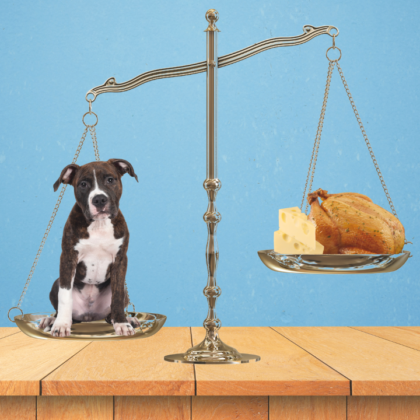Does Your Dog Have A Chicken & Cheese Deficiency?
Positive reinforcement is a pleasant approach to our interactions with animals (and even fellow humans). Used correctly, positive reinforcement can be beautifully nuanced, scalable, infinitely adjustable to the specific animal’s preferences, and calibrated precisely to sending clear messages ranging from “nice job!” to “Holy smokes, what an outstanding decision made under difficult conditions!” In short, R+ is awesome!
What I often see, unfortunately, is a somewhat clunky use of positive reinforcement. The reinforcement often becomes just food treats or maybe a toy rather than a range of possibilities. The pay scale is sometimes just one treat, no matter how difficult the behavior. Rewards can devolve into promises and prompts with the handler reaching for the treat pouch as the dog looks about ready to do X. This happens without the handler even noticing – but the dog sees it and read it correctly, and it all becomes part of the interaction.
The power and the presence of intrinsic reinforcement goes unnoticed or misunderstood, though it speaks to the individual dog’s interests and joys. Instead, we reach for the extrinsic reinforcers which can be powerful, but can also set up both handler and dog for disappointment and frustration when not used with skill. Or when the dog expects to see a prompt or promise.
I read through various forums and discussion groups, so I get to see how a wide range of R+ trainers recommend working with this or that behavior problem. Most troubling to my way of thinking is that many behavior problems are treated as if the dog has a chicken or cheese deficiency. So many techniques frame behavior issues as something that can be addressed with sufficient supplementation of chicken or cheese.
Long before we reach into our stash of chicken and cheese [insert your preferred treats], let’s first check for what might actually be deficient:
- Safety – Does the dog feel safe in that moment, situation or with that expectation? Is the handler supportive and proactive?
- Productive arousal – Is the dog in the Think & Learn Zone (TLZ)? Is their head in the same place as their feet? When, where and why did they leave the TLZ?
- Information – Did the dog get the necessary information in a timely manner? In a meaningful way that suits their sensory awareness? Does the dog have the time they need to process the information?
- Skill(s) – Does the dog know how to be right? When did they learn that? Under what conditions? What do they need to know in order to be successful? Are there any physical limitations?
- Feedback – Does the handler provide timely feedback calibrated to delight and encourage the dog? Too much or too little or no calibration are often ineffective.
Imagine applying the chicken and cheese approach when we meet resistance in a human friend. To get past their resistance, we would simply need to bring out more money, more chocolate or ice cream, more candy, another glass of wine. The end result might be that we can get them to respond the way we want them to. But we risk something serious: our friend might feel that we are ignoring what they are telling us. They may end up feeling pressured into doing something that was uncomfortable for them. That approach is destructive to a relationship, with a human or an animal. It builds distrust and reduces what is possible to a transaction.
When we stop being transactional and oriented on achieving a goal or shifting behavior to suit our needs, when we shift into conversational interactions, our tendency to treat behavior as a chicken or cheese deficiency disappears. We start to understand that resistance is meaningful information. We learn that while positive reinforcement can sweeten the deal, we first need to find a point of agreement and understanding, where respect and listening are the foundation of the conversation.
Want to learn more about rewards, understanding them and using them to build better understanding, and be a better trainer?
All Interesting and Stuff: FREE article discussing the use of real life rewards.
The Power of Social Interactions as Rewards: FREE article discussing the power of food and social interaction.
Rewards, Lures and Bribes Webinar: When used well, reward based training can be incredibly powerful and so much more than just dipping into your stash of chicken & cheese. It’s about listening to that specific dog, providing rewards that are rich and meaningful, including yourself and the celebration of social interaction.
Super Charge Your Rewards Webinar: Building the Bridge to Understanding. Suzanne’s practical information on using rewards effectively, with simple solutions to the oh-so-common “Show me the cookies!” challenge.
—

